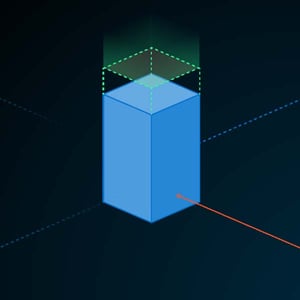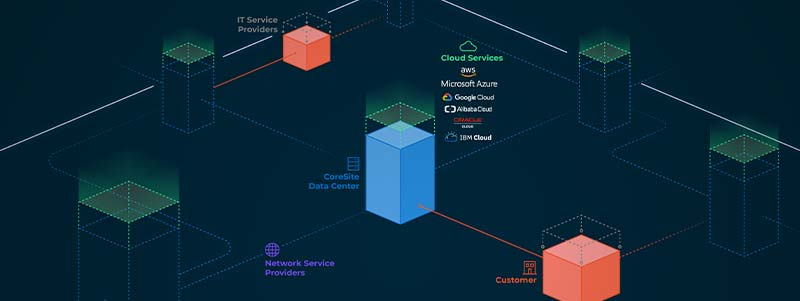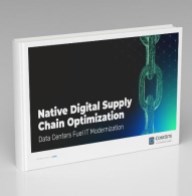
Interconnected Ecosystems – the Real Value of Digital Transformation?
What is the proven value of digital transformation? We ask because recent research shows “two out of five organizations say digital transformation initiatives often fail to achieve the desired business outcomes.”1 And in 2019, Harvard Business Review reported that 70% of all digital transformation initiatives do not reach their goals.2
Actually, that’s okay, especially if you look at digital transformation as an ongoing evolution instead of an end state. Maybe the better question is: How can each organization take advantage of their current stage of digital transformation and position themselves to be ready for multiple possible futures, predictable and unanticipated?
We think two infrastructure pillars are keys for that – cloud and interconnection. Also, from an operational standpoint, working from a perspective of IT modernization (instead of digital transformation end-states) and accepting constant adaptation to be “business as usual” can enable setting and attaining business goals now and down the road.

The Road to Business Agility Runs Through Clouds
The global lockdown in 2020 forced interacting with colleagues, business partners and customers digitally – it was the only option for most businesses. It also accelerated cloud services and multicloud deployments, in turn increasing the interdependence of public and private clouds.
As an aside, it elevated the importance of smart, intentional services distribution to control data transfer and broadband costs – while accelerating digitalization and enterprise-specific process improvement initiatives. Many organizations already were in the midst of rationalizing application distribution when the pandemic hit. COVID elevated the importance of ongoing rationalization and the value of workload distribution agility.
The pandemic made customer experience a more important differentiator than ever. In the report, Executive Predictions 2022, Splunk’s Chief Strategy Officer Ammar Maraqa says, “Gaps in customer experience are always a problem for businesses. But because not everyone was able to really double down on transformation, there’s a real difference in organizations’ digital presence.”
One should expect that trend to continue, and organizations that best use the customer behavior data they collect (which includes business-to-business as well as SaaS user interaction) will have competitive advantages. That’s because the relationship between clouds and customer experience will deepen as edge computing proliferates. Edge clouds will enable further personalizing experiences, thanks to 5G, artificial intelligence and data analytics applied at the point of engagement.
Edge computing helps reduce total cost of operation as well. Each organization can determine which data in edge clouds are valuable enough to them to justify the expense of moving it through hyperscale hosted public clouds and across networks.
Obviously, the road to business agility runs through clouds. Although it’s difficult to measure, it is safe to say that clouds played an important part in helping the global economy recover after COVID shutdowns drove the worst economic downturn since the Great Depression. Cloud spending rose 37% to $29 billion during the first quarter of 2020.4 The economy bounced back and businesses learned that their cloud strategies, even if they were not as mature as others, were critical to their survival.
Interconnection is the Technology Powering Digital Ecosystems
Interconnection is the mechanism tying together the ecosystem of entities each business exchanges data with as part of operations, using what we are calling a “digital native supply chain.” Historically, enterprises, related service providers and cloud providers (and consumers, however you define them) shared data though point-to-point connections within carrier-neutral data centers. As multicloud grew, so did digital ecosystems, which are able to exchange data and use hosted services as needed, at scale and from any location. Simplifying data exchange between clouds would be a good step to holistic interconnection.
Data centers remain the hub for interconnection, which happens through cross connects and virtual connections. The advantages for ecosystems vary, including:
- Security and resilience that only private networks can offer
- Guaranteed performance with latency aligned to need – critical to user experience
- Better decisions, enabled by reducing or eliminating data silos
- Cost control as a result of direct cloud connections and the agility to turn up or down services faster and ever-more selective broadband use (as we should see with edge clouds)
- New revenue opportunities and expanded market reach
At the top of this post, we raised a question about the value of digital transformation. Arguably, if there’s a single measure of the value, it is being able to integrate with digital ecosystems in clouds, whether you are an enterprise, SaaS provider, network carrier or end user/consumer. That’s because as the ecosystem grows, customers of each member are potential new customers for other members. Another plus is that consumers (however defined) welcome the frictionless customer experience provided by ecosystem participants.

However, wide area network interconnection is complex. Enterprises of all sizes typically lack the experience and equipment needed to do so effectively – as you would expect, since they never needed either! That’s where CoreSite can make a huge difference now and in the future. For more than 20 years, we have owned and operated data centers in markets where ecosystems have grown and will keep growing.
Because we are a subsidiary of a wireless infrastructure leader, American Tower Corporation, we are positioned to help you take advantage of wireless/wireline convergence facilitating 5G and the edge. And, we’ve built and enhanced a platform designed to simplify deploying high-performance hybrid IT architectures faster, more securely and at lower total cost of operation than alternative solutions: the Open Cloud Exchange®.
We also have recently released a white paper that takes the discussion here to much deeper levels. Download Native Digital Supply Chain Optimization: Data Centers Fuel IT Modernization to be more informed on the possibilities and advantages of IT modernization.










